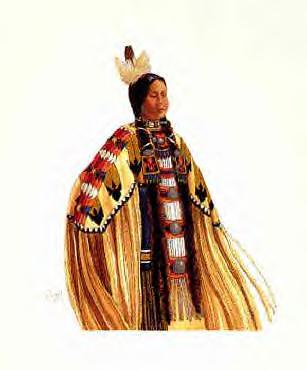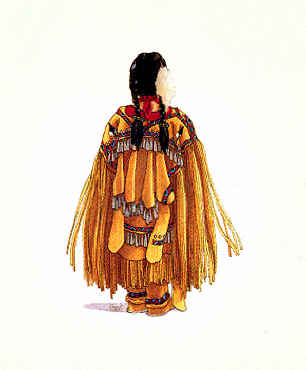|
 The
hot summer sun beats down on your tent. You can feel the heat creeping inside. Just when you can't take it anymore,
you quickly unzip the tent flap and roll your body halfway out, too tired to get to your feet. The
hot summer sun beats down on your tent. You can feel the heat creeping inside. Just when you can't take it anymore,
you quickly unzip the tent flap and roll your body halfway out, too tired to get to your feet.
Nearly every summer weekend day starts the same for teenagers on the powwow trail.
Powwows play a huge role in the lives of many Native American teenagers. The celebrations happen year-round all
over the United States and Canada, but especially in the summer. Summer forever has been labeled powwow season.
Between June and September, the question isn't: "Is there a powwow this weekend?" The question is, "Where
is the powwow this weekend?"
Some of my earliest childhood memories are of going to powwows, rolling around in the dirt, squirting each other
with water pistols, conning my aunts and uncles for money to buy treats.
Many of my peers love rap music. While I like country, and even a little rap, the songs I hear in my head -- the
ones I want to listen to repeatedly -- are powwow songs.
Historically, powwows celebrated a tribe's victory in war or the hunt. Now, they are gatherings that help us define
who we are as Native American people. They give us the chance to get together with our family and friends. At every
powwow, you're bound to meet new family members and make new friends.
The teens who attend powwows today most likely have grown up on the ``powwow trail.'' The powwows help them learn
traditional values such as respect, honor and Native American pride.
When you go to a powwow, you're surrounded by family, whether it's immediate family or extended. And when you know
someone for a long time, they begin to feel like family. You soon find yourself calling them auntie or grandma,
or you introduce them as your cousin.
Powwows have something for everyone. There are concession stands, craft booths, carnivals and rodeos. You walk
around, visiting with family and friends, and go ``snagging'' or flirting.

And, of course, there are drumming, singing and dance competitions. There are men's and women's traditional dances,
the oldest dances. There are women's healing dances and men's grass dances. There are women's jingle dances, where
Copenhagen cans or other pieces of metal are tied to the dancer's dress or regalia to make them jingle.
Each tribe has its own way of dancing. Dancers are judged on their presentation and performance.
But not all the dancing revolves around competition. There are intertribals or all-dance events. There's the round
dance, where you go and shake everyone's hand. There are the owl dances, where couples dance.
And those who want a break from powwow music can go to the white dance, a tent where they play non-native music.
Everyone, whether tribal members or non-Indians, is welcome to participate.
|